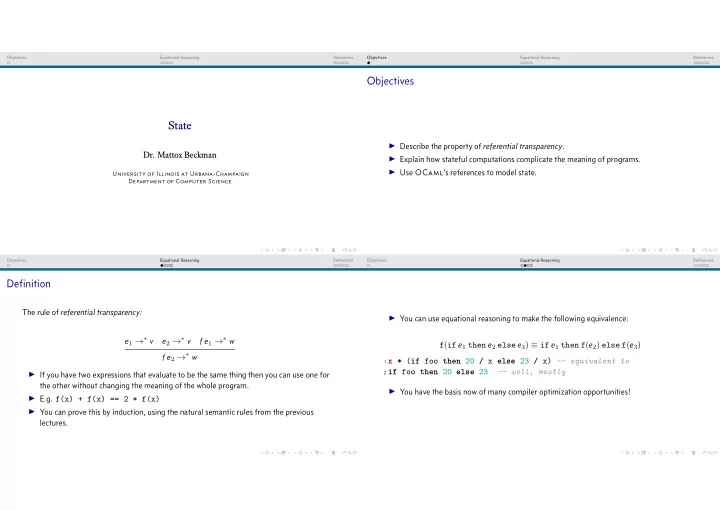

-- well, mostly Objectives Equational Reasoning References Objectives Equational Reasoning References Objectives State ◮ Describe the property of referential transparency . Dr. Mattox Beckman ◮ Explain how stateful computations complicate the meaning of programs. ◮ Use OCaml ’s references to model state. University of Illinois at Urbana-Champaign Department of Computer Science Objectives Equational Reasoning References Objectives Equational Reasoning References Defjnition The rule of referential transparency: ◮ You can use equational reasoning to make the following equivalence: e 1 → ∗ v e 2 → ∗ v f e 1 → ∗ w f ( if e 1 then e 2 else e 3 ) ≡ if e 1 then f ( e 2 ) else f ( e 3 ) f e 2 → ∗ w 1 x * ( if foo then 20 / x else 23 / x) -- equivalent to ◮ If you have two expressions that evaluate to be the same thing then you can use one for 2 if foo then 20 else 23 the other without changing the meaning of the whole program. ◮ You have the basis now of many compiler optimization opportunities! ◮ E.g. f(x) + f(x) == 2 * f(x) ◮ You can prove this by induction, using the natural semantic rules from the previous lectures.
Objectives Equational Reasoning References Objectives Equational Reasoning References A Complication A Counterexample 1 # let counter = -- something 2 val counter : unit -> int = <fun> ◮ f(x) + f(x) == 2 * f(x) 3 # counter () ;; 1 # 2 * counter () ;; 4 - : int = 1 2 - : int = 8 5 # counter () ;; 3 # counter () + counter () ;; 6 - : int = 2 4 - : int = 11 7 # counter () ;; 8 - : int = 3 ◮ Congratulations. You just broke mathematics. 9 # ◮ Can we still use equational reasoning to talk about programs now? Objectives Equational Reasoning References Objectives Equational Reasoning References Reference Operator Natural Semantics e ⇓ v , where $ i is a free location in the state, initialized to v . ref e ⇓ $ i Transition Semantics ref v → $ i , where $ i is a free location in the state, initialized to v . e ⇓ $ i , if state location $ i contains v . ! $ i → v , if state location $ i contains v . ! e ⇓ v $ i := v → () , and state location $ i is assigned v . (); e → e e 1 ⇓ $ i e 2 ⇓ v , and location $ i is set to v . Note that references are different than pointers: once created, they cannot be moved, only e 1 := e 2 ⇓ () assigned to and read from. e 1 ⇓ () e 2 ⇓ v e 1 ; e 2 ⇓ v
! ct ;; ct := ! ct + 1 ; Objectives Equational Reasoning References Objectives Equational Reasoning References Counter, Method 1 Bad Things for Counter 1 # let ct = ref 0 ;; ct is globally defjned. Two bad things could occur because of this. 2 val ct : int ref = { contents = 0 } 1. What if you already had a global variable ct defjned? 3 # let counter () = ◮ Correct solution: use modules. 4 2. The Stupid User TM might decide to change ct just for fun. 5 ◮ Now your counter won’t work like it’s supposed to! 6 val counter : unit -> int = <fun> ◮ Now you can’t change the representation without getting tech support calls. 7 # counter () ;; ◮ Remember the idea of abstraction . 8 - : int = 1 9 # counter () ;; 10 - : int = 2 Objectives Equational Reasoning References Conclusions about State State is bad because: ◮ It breaks our ability to use equational reasoning. ◮ Users can get to our global variables and change them without permission. State is good because: ◮ Certain constructs are almost impossible without state (e.g., graphs). ◮ Our world is a stateful one.
Recommend
More recommend